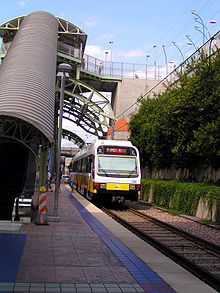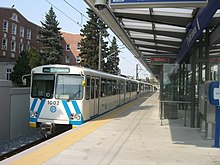You may have heard that yesterday (Dec. 13, 2011) a decision was made to cancel Detroit's Woodward Avenue Light Rail project, and to substitute instead a "rapid bus" system that would serve four Detroit corridors.
In an interview with Fox 2 News (linked below), Detroit Mayor Dave Bing is quoted as saying, "I don't think we should concentrate all of our efforts on the Woodward light rail. I think we've got to look at this region and do what's best for the region." A
Detroit News article, "Light rail backers push Woodward line as bus system proposed", outlines the details and includes interviews with people who back the light rail system.
Does this mean the light rail plan is history? Another ambitious plan for Detroit that falls into oblivion? Possibly. Moneyed backers of the light rail system are reluctant to give it up, so some semblance of the proposed system may yet be built.Either way, now is a good time to look more closely at rapid bus in comparison with light rail. When transportation nerds hear "rapid bus", we think "Bus Rapid Transit" (BRT). But I'm not at all convinced that the Detroit plan will actually involve BRT - at least, not at first.

You see, some statements made by Gov. Snyder and his spokespeople a couple of months ago about the low cost of rapid bus, when Snyder announced his plan for Detroit transit, lead me to believe either of two possibilities: they may not understand what is really involved in"Bus Rapid Transit", or they may have used the term "rapid bus"because they envision something simpler and less expensive.
Here's a little table outlining the similarities and differences between Light Rail, true Bus Rapid Transit, and rapid buses:
Light rail is a well-established transit mode that runs on rails, usually on its ownright-of-way. The Detroit plan called for mixing with traffic in the downtown area to give better access to local businesses. Over most of the line, stations were located about a half-mile apart, though the downtown area had closer spacing. Compared with buses, light rail is relatively inexpensive to operate. Each 120-foot train holds about three times as many passengers as the 60-foot buses normally used for BRT; each train and bus is operated by one driver, and since personnel is typically the largest cost, running BRT buses costs roughly three times as much as running a light rail train. Also less expensive is the energy for moving them: electricity for the trains,versus diesel or natural gas for the buses. However, to those low costs we must add the cost of maintaining the track and electric wires, while normally only the pavement would be a factor for the buses.
Bus Rapid Transit in its pure form is designed to work like a light rail train on rubber tires. It has its own right of way, similar station spacing, and people board at stations after paying their fare. The station platform is level with the floor of the bus, so people, strollers,and wheel chairs can roll on and off without having to lower the bus,deploy a ramp, or slow the boarding process in any way. When crossing streets, the approach of a bus changes the signal so the bus can proceed without stopping. Everything is designed to move people as efficiently as possible. But as you can imagine, dedicating a lane to nothing but buses, building stations, and purchasing large,specialized buses makes BRT pretty expensive compared with other kinds of bus service.
Rapid (or Express) bus is primarily a way of using ordinary buses on existing streets or freeways to speed up service at a minimum of cost. The buses stop less frequently than local buses, and in some cases have devices that give them some amount of precedence at intersections. Rapid bus routes are inexpensive to set up, since they don't necessarily need special stations, equipment, or lanes. But they sacrifice many of the advantages of either light rail or BRT systems: they are slower and less comfortable, because they stop and start much more frequently. Boarding is slower if fares are collected by the driver as passengers get on.
Los Angeles provides good examples of all three of these transit modes (see links below). The Blue, Green, and Gold line are light rail; the Orange Line is BRT,and there are 26 rapid bus routes in addition to multiple local bus lines. (The Red and Purple lines are what's known as "heavy-rail"subways.) I've ridden the Blue, Green, Gold, Red, and Orange lines,but not the rapid buses. The Orange Line runs from North Hollywood to Canoga, part of the way in the wide median of Chandler Boulevard, the rest of the way on the old right of way of Southern Pacific Railroad's Burbank Branch; it is being extended to Chatsworth. I rode it in October of 2007 in mid and late afternoon, and found the bus a little bumpy and jerky, but well patronized. (The buses are equipped with TVs, but what do you expect in Hollywood?) During rush hours,the BRT system now operates at capacity due to high ridership, and the LA transit authority is experimenting with ways to increase capacity, such as using longer buses or running buses in "fleets"of two or three.

The LA Transit "Metro Rapid" and similar area services use articulated buses, for the most part,similar to those on the Orange Line (but painted different colors). They stop at bus shelters (not stations) and are built with low floors to make boarding more rapid. Some of the bus shelters are equipped with "next bus arrival" signs. In the City of Los Angeles, traffic signals along their route recognize the buses' presence and change to let them through, but outside the city many of the signals aren't equipped to recognize them, and don't give them precedence. Their speed and passenger-carrying capacity is less than that of light rail or the Orange Line BRT, but greater than that of the local buses.
Development incentive is probably the the most important difference for a metropolitan region choosing between light rail, BRT, and rapid bus systems. Light rail systems built recently in several U.S. cities have spurred tremendous investment in developments around the stations. Four to eight dollars of private investment is widely reported for every dollar spent building light rail. Most observers agree that rails in the ground give developers confidence that the service will be around for the long term, and that lots of people will be riding.
BRT figures aren't so easy to come by in this country. The systems I've looked at personally (Los Angeles and Cleveland) don't appear to have attracted much development that wouldn't have happened anyway. However, Enrique Peñalosa,who spearheaded the BRT system in Bogotá, Colombia, points to tremendous development near the BRT corridors of his city. Bogotáhas no other rapid transit in competition with BRT, whereas both LA and Cleveland have rail transportation options, which experience shows to attract development quite reliably.
There is no evidence that I know of to indicate that rapid or express buses stimulate development. Because they have so little fixed infrastructure, there is no assurance for developers that their investment would be safe.
Perhaps in Detroit, with few rapid transit options other than BRT, it would attract some of the development we've been looking for from a light rail system. We can hope - and push for - a true BRT system. But let's not give up on light rail: experience around the country shows light rail is really what attracts private investment to cities.











